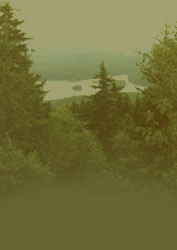|
Do you have something
happening in your corner of Washington? - Please call a member
or e-mail your observations to have them included here
December:
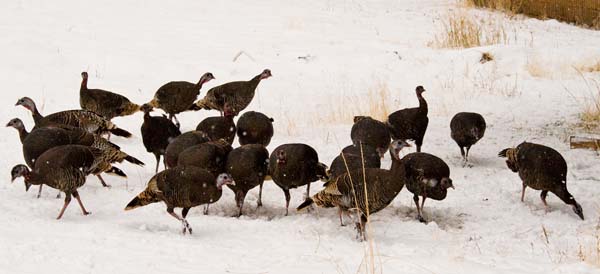
Turkey picture by Lu Giddings Audubon Guides
Help NH Fish and Game with their Winter Turkey Count!
You can help New Hampshire Fish and Game this winter by reporting wild turkey flocks you see locally from January 1 to March 31. Each year, N.H. Fish and Game's winter wild turkey flock survey helps biologists assess the impact of winter weather on our turkey population. Report your observations of winter wild turkey flocks at their online reporting site here: Turkey Survey
You can also find links to the past winters' surveys and summers' surveys at this link. Thanks for helping!
Some people like to feed wild turkeys during the winter thinking that it helps them survive. The N.H. Fish and Game Department discourages people from purposefully feeding turkeys because doing so enhances the likelihood of disease, predation, and human conflicts. While the Fish and Game Department does not advocate wildlife feeding, they recognize that turkey feeding will at times take place with or without our input. They also recognize that poor feeding practices may do more harm than good. Therefore, and in response to numerous inquiries from the general public, They offer the following information: Feeding guidelines
Even better than feeding turkeys is creating some Wild Turkey Habitat! Prime winter habitat has at least 50 percent mature hardwood forest. Tree species important to turkeys include a variety of oaks, which, if mature, produce large quantities of acorns (or mast). Acorns and other mast are the staple of the turkey's winter diet. In agricultural areas, turkeys often depend on crop fields with waste grain for winter food.
Nesting habitat is quite varied, but hens usually nest near the edges of old fields, along trails, in hay fields or in patches of briar or similar vegetation. Also, most turkey nests are located close to a source of permanent water.
Summer and fall habitats consist of mowed hay fields, grazed pastures, glades or open woods. These areas are extremely important to hens and their poults. Low plant cover provides abundant insects and seeds.
Wild turkeys require water and are not found in areas without a permanent water source.
Finally, in most of the Northeast, some of the best wild turkey habitat is provided by small, family-owned, dairy farms. The woodlots, field-edges and hedgerows associated with small dairy farms provide ample nesting habitat. The hay fields and pastures provide high quality brood habitat. Waste grain from silage, corn and small grain production provides late summer and fall food. Manure spread on the fields provides a constant winter food source. One of the best things that you can do for the wild turkey is to actively support the small dairy industry in your community and state. Keep the Eccardt Farm and other local farms in business - they are the key to your local turkey population and other wildlife!
October:
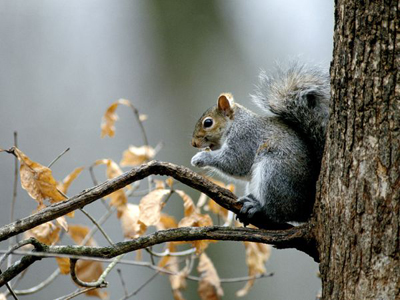
Squirrel picture by Chris Johns nationalgeographic.com
A "plague" of squirrels?
Since the middle of the summer, Conservation Commission members have been commenting on odd squirrel behavior. We didn't know why we were seeing what we were seeing, but we knew it was strange. The local gray and red squirrels seemed extra hungry and were going after things in the garden and yard that they never touched before. Sunflowers picked off their stems and even taken out of vases on the porch for their seeds. Pears and apples taken off the trees before they were ripe, disappearing by the bushel overnight. Tomatoes nibbled and pilfered and recently pumpkins and squash chewed and opened up for their seeds. We were perplexed, but now we know there were several reasons why this was happening and it is pretty rare. The following excerpt of an article found in the Concord Monitor, written by Wilson Ring of the The Associated Press, answered some of our questions.
Don't let the bright eyes and bushy tails fool you. These squirrels are up to no good. Last year's mild winter and a bumper crop of nuts have caused an apparent explosion in the squirrel population in patches of the country, bewildering fruit growers with their ravenous appetites, littering highway shoulders as roadkill, and keeping homeowners and pest control experts busy.
In southern Vermont, Clarence Boston said he hasn't seen such an infestation of pests in the 33 years he has been an orchardist on 60 farms in five states.
The squirrels wait until his apple crop is nearly ripe to swarm into the trees from nearby forests, sometimes eating half a tree's fruit in two or three hours. Sometimes, the squirrels will take only one bite, but the teeth marks make the apples worthless for retail sale.Squirrels destroyed about half of his most profitable variety of apples after a season already made tough by the weather.
Biologists know squirrel populations have rare but periodic "eruptions," when conditions coincide to produce abundant foods that fuel the fast-reproducing animals. This year's squirrel boom in parts of Vermont followed two seasons of bountiful acorn and beechnut crops and last year's mild winter.
In addition to eating up cash crops, squirrels can also prevent future harvests by "girdling" trees - eating away a band of bark around the trunk, causing it to die.
The same conditions are contributing to increases in other rodents, such as certain species of mice, experts say.
Trying to get a precise measurement of the scope of the infestation is difficult. The population booms appear to be happening in some places, but not others.
Curtis said he has heard of problems in New York's Hudson Valley, north of New York City, but not in western New York. Similar booms have been reported in New Mexico, and squirrel hunters in Indiana and Ohio are expecting banner seasons. But hunters in Pennsylvania are being told it could be a tough season.
In Vermont, at least, the plague is expected to end this winter. After two good nut seasons, this year saw poor acorn and beechnut crops. That could be contributing to high activity as many squirrels look for food elsewhere.
For farmers, the beginning of the end is of little consolation in the here and now.
Before this year, John Barber never had a problem with squirrels at his 25-acre Apple Hill Orchard in Whitehall, N.Y. Now the animals are building nests in his trees and sampling different varieties of apples as the fruit matures, staying one step ahead of his pickers. He estimates, conservatively, that he is going to lose 15 to 20 percent of his crop. "Usually your best fruit is the fruit that's fully exposed to the sun; it gets the best color to it," Barber said. "Your size is usually out on the upper canopy of the tree. That's what they're doing; they're climbing up into the upper canopy."
Farmers aren't the only ones reporting problems.
Drivers are dodging squirrels that dart across roads or skirting ones that are killed while crossing. Squirrels can also move into attics and build nests, creating a mess with droppings and urine. Homeowners commonly complain they can hear the pests scurrying through their attics at 4 a.m. They'll chew through wires, which can cause fires.
Our observations caught the first signs of this population boom and the article gave us the reasons why. Keep your eyes open for things happening in the natural world and let us know what you are seeing!
Read the whole article here: Concord Monitor
September:
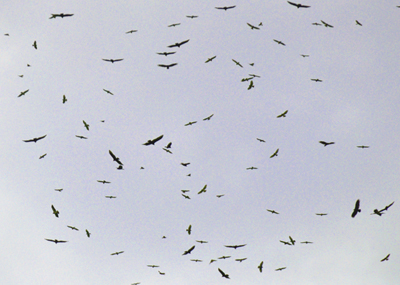
Raptors soaring blogs.agu.org
September is the time for Raptor Watching!
The group of birds known as diurnal raptors are birds of prey that are sometimes referred to simply as “hawks.” They include eagles, falcons, ospreys, vultures, kites and harriers as well as hawks. They range in size from the diminutive American kestrel (not much bigger than a robin) to the massive bald eagle with a wingspan of more than six and a half feet. We regularly observe and count 14 species at NH Audubon’s Raptor Observatories.
During the fall migration season, NH Audubon welcomes visitors to raptor observatories at Carter Hill Orchard in Concord and Pack Monadnock at Miller State Park in Peterborough. As thousands of raptors pass overhead, NH Audubon staff tally birds as part of an international effort to monitor raptor population trends in the Americas. Thousands of visitors – including hundreds of students from across the region – come to the observatories to learn about raptor identification, and to experience the spectacle of raptor migration.
Audubon's Raptor Observatories Information
Other Spots to See Raptors:
Get out your bird books and binoculars and head for these popular New Hampshire hawk-watching spots. The best locations are high, with an open view to the north-northwest. Be sure to dress for the weather.
Mount Kearsarge, Wilmot: From I-93, take I-89 north to Exit 10. Follow the signs to Winslow State Park on Kearsarge Mountain Road off Route 11. A one-mile foot trail leads from the picnic area to the summit.
Pitcher Mountain, Stoddard: Trailhead is on Route 123 northeast of Keene, about 5 miles west of the junction with Route 9. There’s a half-mile trail to the firetower at the peak.
Blue Job Mountain, Farmington: From Route 202A between Center Strafford and Rochester, take Crown Point Road 5.6 miles. Two trails lead a half-mile to the summit.
Little Round Top, Bristol: Take Exit 23 off I-93 and head west. In Bristol, take Route 3A south; at the Historical Society, turn right on High Street, then right on New Chester Mountain Road. A trail through the woods leads to a small fire road that ends at the summit.
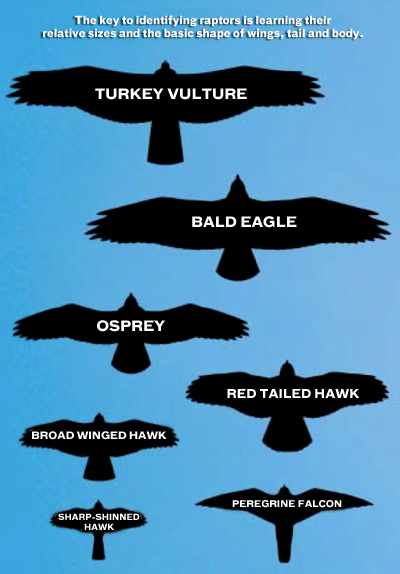
Raptor Silhouettes NH Wildlife Journal
As many as 15 different raptor species pass over New Hampshire during the fall migration, from the broad-winged hawks that migrate in mid-September to rough-legged hawks and golden eagles later in the season. Such variety can keep you on your toes as you attempt to tell a sharp-shinned from a Cooper’s hawk. Brush up on how these birds of prey compare in size and shape.
The second or third week of September is peak hawk-viewing time in New Hampshire, as large flocks, or “kettles” of broad-winged hawks pass over, conserving energy by riding big thermal air currents along ridgelines and river valleys on their trek to wintering sites in Central and South America. These high-flying birds are among the first to begin the journey.
Hawks are not the only birds of prey on the move southward. You may spot a peregrine falcon on its way to Central or South America (look close for the telltale black mustache visible down either side of its face). Other members of the falcon family include American kestrels and merlins. Falcons are strong, fast fliers and have a characteristic streamlined body shape, long pointed wings and tail that narrows at the tip.
In late September and October, there’s a good chance you’ll see a migrating osprey in the mix. Ospreys are rebounding in New Hampshire now after drastic declines in the last century linked to pesticides. Osprey hold their wings in an arched position, giving them a shallow M shape, with a black spot marking the outer edge of the wing. Unlike the broad-wings, ospreys don’t need perfect traveling weather – you may see them on the move even on a blustery day.
Another thrill is the possibility of seeing a bald eagle. Eagles do sometimes migrate, though adults tend to stay near their nesting territory as long as food is available. Of course you’ll recognize the distinctive white head and tail of the adults, and you can’t miss their tremendous size and flat appearance while soaring. Young bald eagles are dark with blotches of white on parts of the wings and tail nearest the body.
What’s that other massive silhouette drifting by on the thermals? Not a raptor, an important member of nature’s clean-up crew — the carrion-eating turkey vulture — is heading south for the winter, too; its broad wingspan and wings tipping upward in a distinctive V shape make the vulture easy to recognize.
Information found at: NH Wildlife Journal
August:
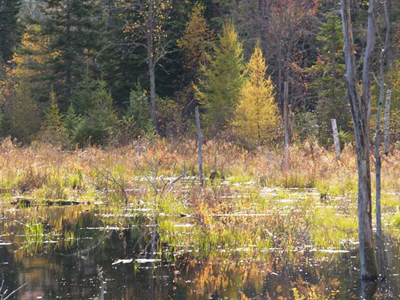
Forested Wetland picture by Hikenewengland.com
Wetlands – What They Do for You
The word “swamp” may evoke a dark, wet, threatening place, but swamps are actually forested wetlands – New Hampshire’s most common type of wetland. For centuries, people considered them wastelands and spent tremendous efforts ditching or filling them. Within the latter part of the 20th century, people have come to realize that wetlands are critical to the health of our environment and its inhabitants.
New Hampshire is about 6 to 10 percent wetlands, which reflect its glacial history. Approximately 97 percent of those wetlands are nontidal and 3 percent are tidal wetlands. Since the 18th century, about 50 percent of the tidal wetlands and about 10 percent of the nontidal wetlands have been destroyed. Compared to other states, however, New Hampshire has done well; it is one of three states that have retained more than 80 percent of its wetlands since 1780.
Wetlands have water at or near the surface and saturated soils for part of the year, and plants that are tolerant of wet conditions. As wetlands disappear, so do the benefits we derive from them, including reduction of flood flows, recreation, maintenance of water quality and quantity, erosion control and wildlife habitat.
Wetlands Support Water Quality and Drinking Water -
Wetlands protect the quality of water in our lakes and streams. They remove excess nitrogen and retain sediments with contaminants – such as metals or the nutrient phosphorus. This prevents the nutrients and contaminants from entering the waterways, thus ensuring the quality of waters downstream. Water quality is important as surface water is the drinking water source for 40 percent of the state’s population. Water quality is important for the animals that live in surface waters. In tidal areas, retention of sediment is especially important to minimize siltation in shellfish beds.
Wetlands Moderate High and Lows Flows -
Wetlands slow runoff from upland areas and release it slowly, which results in a reduction of peak flood flows and, consequently, less flood damage downstream. Wetlands maintain instream flows in dry periods. Since groundwater is often discharged into wetlands, and wetlands “feed” streams, streams continue to flow for a longer amount of time where wetlands are present. This is important for water supply and wildlife habitat.
Wetlands Protect Shorelines -
Wetlands located along waterways and shorelines buffer the natural wind and waves as well as the humangenerated waves from boating activity. In addition, erosion and sedimentation are reduced when organic matter accumulates and provides a surface on which other plants may grow.
Wetlands support recreation ... and the economy -
Among the 50 states, New Hampshire’s economy ranks seventh in its reliance on travel and tourism. It is the second largest industry in the state. Travel and tourism brings more than $4 billion annually into the economy and employs more than 65,000 residents. In 2006, residents and visitors spent $525 million in New Hampshire for fishing, hunting and wildlife watching, and swimming. Hunting alone generates $71 million in revenue and provides more than 1,400 jobs. A significant part of the tourism monies are there because of New Hampshire’s natural features – clean lakes and wildlife.
Wetlands Support Wildlife -
Wetlands provide essential habitat for wildlife. Wetlands support almost twothirds of New Hampshire’s wildlife in greatest need of conservation. Some small seasonal surface waters known as vernal pools – temporarily flooded depressions that lack breeding fish populations – are the breeding habitat for amphibian species that live in upland area most of the year. Larger wildlife, such as moose, depends on wetlands for their food source as well.
Fisheries -
Estuarine areas and coastal marshes, where saltwaters and freshwaters mix, are among the most ecologicallyproductive areas in the world. In tidal areas, retention of sediment is especially important to minimize the deposition of fine sand or silt in shellfish beds. Tidal wetlands serve as spawning and nursery areas for fish, including those that are commercially harvested. About 32 percent of the commercial fish and shellfish harvested in the northeast Atlantic are dependent on estuaries and the wetlands that are an integral part of estuarine ecosystems. Commercial fisheries harvests in New Hampshire were valued at $19 million in 2007.
Get outside and explore wetlands!
Visit a bog, marsh, swamp or floodplain forest or vernal pool in your town.
Participate in a wetland walk, canoe trip, bird watch, or other outdoor activity.
Take a hike with family and friends.
Visit NHOutdoors.com or NHDFL.org for more ideas.
Reprinted from "GREENWorks - Ideas for a Cleaner Environment"
Published monthly by the NH Department of Environmental Services Watershed Assistance Program, Concord, NH (603) 271-7889, May 2009
Find the article here: NH DES
July:
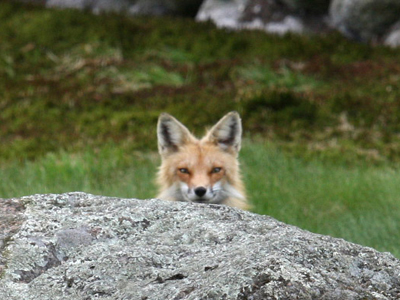
Red fox - watchful mom, picture by Bob Hofstetter
Our Washington neighbors have been keeping an eye out for some of the great wildlife we are fortunate to have living in our midst.
Bob Hofstetter has been observing a mother Red Fox and her current litter of kits. Every year she has her brood under a local barn and you can watch her little ones as they grow and play together.
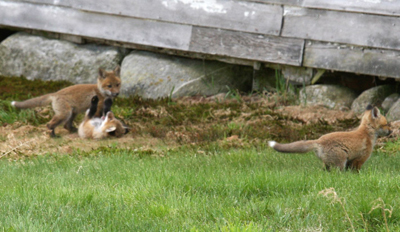
Red fox kits, picture by Bob Hofstetter
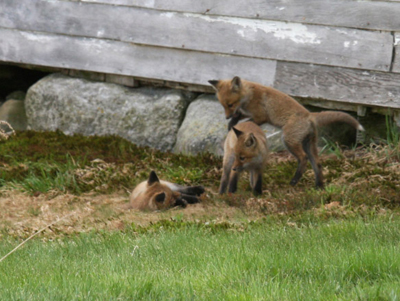
Red fox kits at play, picture by Bob Hofstetter
Lynn Hendrickson had a visit from some skunk babies.
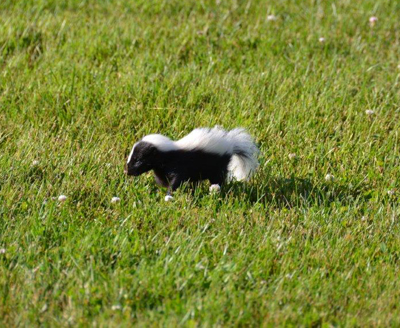
Skunk baby, picture by Lynn Hendrickson
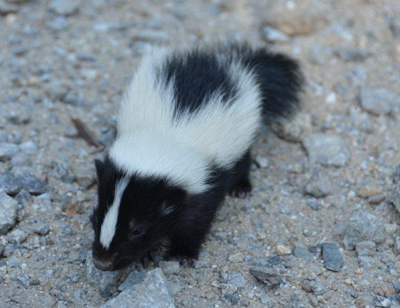
Skunk baby, picture by Lynn Hendrickson
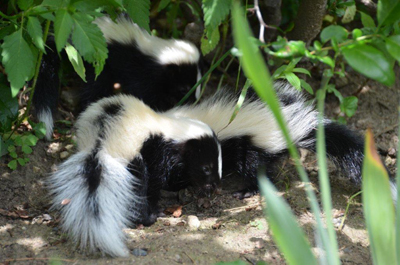
Three skunk babies, picture by Lynn Hendrickson
Arin Mills caught this Turkey Vulture on Faxon Hill Road.
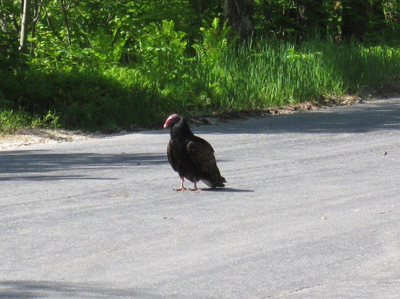
Turkey Vulture, picture by Arin Mills
Johanna Young saw this Grey Tree Frog, he fell out of the tree where he should have been found and he would usually be active only at night, singing his tune.
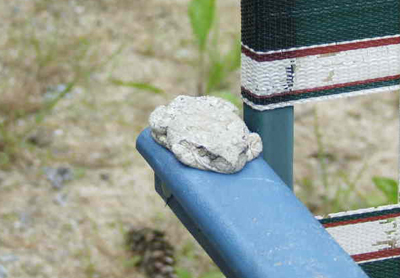
Tree Frog, picture by Johanna Young
She was also visited by a curious raccoon, near her pond.
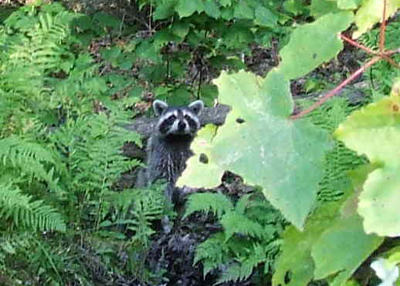
Raccoon, picture by Johanna Young
She caught this Snapping Turtle basking on a log in her pond.
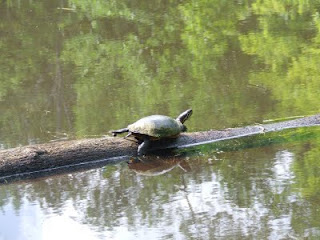
Snapping Turtle, picture by Johanna Young
Ken Eastman caught this Snapping Turtle laying her eggs near his front walk. It wasn't the first time she came to lay her eggs in this spot.
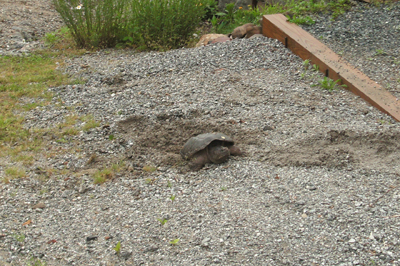
Snapping Turtle laying her eggs, picture by Ken Eastman
Johanna Young saw this handsome green frog when we were picking up trash on our Adopt-a-Highway route.
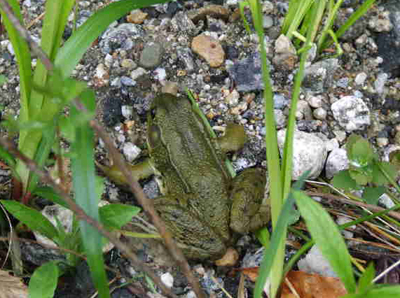
Green Frog, picture by Johanna Young
Please send us pictures of any wildlife you encounter around town and we will include yours next time. You can email them to us at: wcc@washingtonnh.org
Happy hunting!
June:
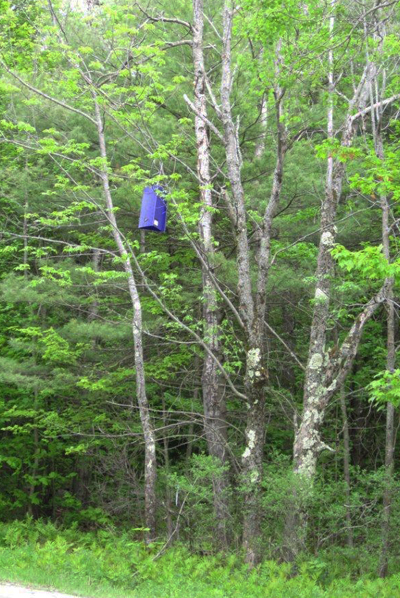
Emerald Ash Borer trap picture by Arin Mills
Purple boxes looking like box kites are being hung in New Hampshire ash trees as part of efforts to detect the presence of the Emerald Ash Borer, an invasive insect that had obliterated ash forests throughout the Midwest. The purple boxes are sticky and contain a pheromone to attract the insects.
The U.S. Department of Agriculture Animal and Plant Health Inspection Service and the New Hampshire Department of Agriculture, Markets & Food are joining with a natural resources company to survey for the beetle (Agrilus planipennis), a wood-boring insect that has attacked and destroyed over 50 million ash trees in 15 states. Ash trees make up about 15% of New Hampshire’s forests and their loss would be devastating. The beetle larvae bore into the trunk and major branches of native ash trees and destroy the water and nutrient transporting layers and eventually kill the tree.
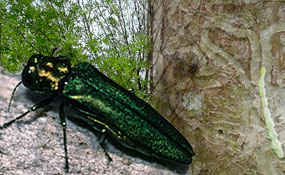
Emerald Ash Borer picture US Forest Service
The metallic green beetle is native to Asia (specifically eastern Russia, northern China, Japan, and Korea. It was first found in the Detroit area in 2002, but it’s believed to have been accidentally imported in the 1990s, perhaps in ash wood or packing materials from overseas.
As of 2011, the borer hadn’t been detected in New Hampshire, but it’s getting closer to the state. It has been detected south of Montreal, and recently it was found east of the Hudson River in New York.
New Hampshire has established a firewood quarantine to prevent the importation of non-treated wood because transporting ash wood for use as firewood is also a major way infestations spread.
How can you help? Don’t transport firewood and learn to identify signs of infestation. Together, we can hopefully prevent this insect from entering New Hampshire and killing our ash trees.
For more information about emerald ash borer or the survey program, contact the N.H. Department of Agriculture, Markets & Food, Division of Plant Industry, at 271-2561 or NH Department of Agricuture .
More information about the Emerald Ash Borer: UNH Cooperative Extension
May:

Eastern Tiger Swallowtail picture by Nan Schwartz
What do hummingbirds, orioles, butterflies, bats, bees, wasps and moths have in common? They are all nectar drinkers! They are all specially designed to collect their nectar meals and help with pollination at the same time.
Nectar is the sugar-rich liquid produced by plants and used to attract pollinators such as insects, bats and birds. The quantity and composition of nectar varies for each flower species, but generally contains mostly water and sugar with trace amounts of proteins, salts and amino acids. Nectar secretion increases as a flower is visited by pollinators and after pollination the nectar is frequently reabsorbed into the plant. Nectar is an ecologically important item and is the sugar source for honey.
Adult butterflies can only feed on liquids and usually seek out nectar. Butterflies and moths both have a proboscis, which functions as a drinking straw. It stays curled up under the butterfly's chin until it finds a source of nectar or other liquid nutrition. It then unfurls the long, tubular structure and sips up a meal.
Hummingbirds have special bill shapes adapted to the certain flowers they drink from. They drink by using protrusible grooved or trough-like tongues. Hummingbirds do not spend all day flying, as the energy cost would be prohibitive; the majority of their activity consists of sitting or perching. Hummingbirds feed in many small meals, consuming up to twelve times their own body weight in nectar each day.
Nectar feeding bats are mostly found in the south western US and Mexico. They feed on blooming and fruiting plants such as agave and saguaro cactus. The three species of long-nosed, nectar-feeding bats that may be seen in the U.S. are: the Mexican long-tongued bat, the lesser long-nosed bat, and the Mexican long-nosed bat. These bats have long muzzles and long protruding tongues that have a brush tip for gathering pollen quickly and efficiently. Nectar bats are excellent long-distance fliers and they migrate long distances to follow the blooming seasons of their favored plants.
Bees and wasps have a tongue which they can dip into shallow nectaries on a flower to sip nectar. Their long tongues that can reach deep into flowers of red clover, vetch, and honeysuckle.
While some of these creatures are drinking the nectar, they also gather pollen from the plants by touching other flower parts. As they fly from flower to flower, some of the pollen falls off of them and back onto the plants. This pollinates, or fertilizes, the plants so that they can produce seeds and spread.
Do you want to attract some of these nectar drinkers to your yard? If you plant a few native plants in your gardens, plants such as butterfly weed, lobelia, bee balm, columbine, trumpet honeysuckle, penstemon, zinnia, nicotiana, you will provide these nectar drinkers with the food they need and they will in turn pollinate your plants and provide you with an interesting show to watch.
Information found at: Discoverseaz/Bats and
Insects.about.com and
Wikipedia/hummingbirds and
Wikipedia/Nectar
April:

Artesian Picture by Maine.gov Dug Well Picture by commonweeder.com
Have you had your well water tested? Whether you have a dug well or an artesian well it is a good idea to check the quality of your water.
Safe drinking water is important to health, and testing well water at a certified lab is the only way to know whether water from a private well is safe. Both human-caused and naturally occurring contaminants are often found in private wells. Nitrates and bacteria, which can lead to immediate and serious health conditions, may be found in well water as a result of a poorly performing septic system or a nearby agricultural source. Across the northeastern U.S., two naturally occurring elements, arsenic and radon, are also commonly found in well water. Scientific studies associate their long-term exposure with cancer and other health effects.
The New Hampshire Department of Environmental Services (NHDES) and the Dartmouth Toxic Metals Superfund Research Program are urging homeowners in New Hampshire to test their well water to ensure their drinking water is clean and safe for consumption. Nearly 40 percent of New Hampshire residents get their drinking water from domestic (private) wells, which are not subject to the same water quality testing regulations as public water systems.
They are working together to raise awareness among health care providers, town officials and private well owners in New Hampshire about the importance of testing private wells to reduce exposure to harmful contaminants.
Testing the quality of well water is simple and relatively inexpensive. NHDES recommends testing private well water annually for nitrates and bacteria, while other contaminants should be tested for every three to five years. A good time to remember to test is National Ground Water Awareness Week, which this year was March 11-17. Testing when moving or buying property is also a good idea.
NH DES offers a private well testing brochure that includes a list of recommended water quality tests and a testing schedule. The brochure is online at DES Well Testing.
A guide for testing is available online here: DES Water Testing, which includes instructions, the submittal form and pricing.
Water testing containers are available from DES at: DES bottles for testing, but also are available at the Recycling/Transfer Station in Washington (Please ask the attendant for water testing bottles). Washington's Health Officer, Jim Berry, can also help.
Information about the Laboratory Services Unit at DES in Concord can be found here: DES Lab Services info. You can drop your water samples there for testing.
To learn more about the health effects of arsenic, current research and community engagement initiatives at Dartmouth College, visit Dartmouth Toxic metals and Children's health
"In Small Doses: Arsenic" is a ten minute movie about the risks associated with exposure to potentially harmful amounts of arsenic in private well water. Please see the video found at Arsenic in Water movie
For additional information about wells, read DES fact sheets at
Well fact sheets.
Don't wonder what's in your well water, test it today!
March:
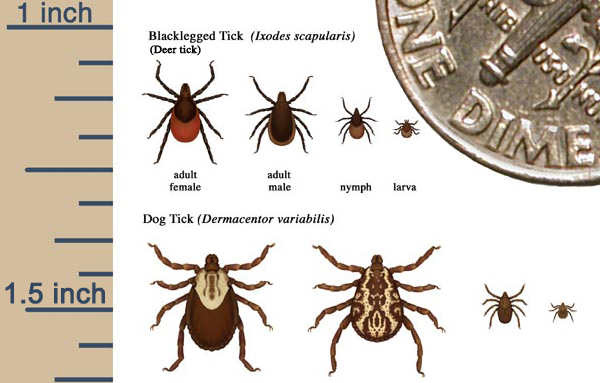
Picture by jpmosquitocontrol.com
Yikes, a tick!
The mild winter with little snow is leading into an early tick season! Jed found 2 ticks on him in the last few days after spending time outside. Ticks are most active from April to August, but in mild winters ticks can be active all year long.
New Hampshire has several kinds of ticks.
The American dog Tick, is the most frequently encountered tick in New Hampshire. It is about 1/8" long, brown and tan, with an obvious mottled pattern of surface markings on the back (opposite the belly side).
The Winter Tick, is similar in size and appearance to the American dog tick. It is often found on moose, deer, or horses during the fall, winter or spring. It doesn’t commonly bite people, and does not transmit agents that cause disease in people.
The Blacklegged Tick (also know as the deer tick), is our second most common species. It is smaller and more rounded than the dog tick. Adult males are very dark brown, almost black. Adult females are two-toned: dark chestnut brown on head, legs and scutum, and orange-red on the rear half of the body. Nymphs are about the size of a poppy seed, and adults are just over 1/16" long, closer to the size of a sesame seed. This species transmits the organism that causes Lyme disease and two additional pathogens that cause babesiosis and anaplasmosis in people.
Ticks become infected after feeding on infected mice and other small mammals, such as chipmunks. Deer play a critical role in the reproduction of the deer tick by transporting ticks from property to property as they move throughout their territory, but they do not infect ticks with Lyme disease.
Ticks wait and grasp passing hosts from tips of grass, low-lying shrubs, and leaf litter. Most ticks grasp onto the lower leg and then crawl up the body seeking a warm place to feed and hide. Deer ticks live in the woods, sustained by the higher humidity levels of the forest or in shaded, sheltered areas.
Dress properly when entering areas which may be tick habitats. Wear light-colored clothes so ticks can easily be seen, wear a hat, long-sleeved shirt and long pants and tuck shirts into pants, and pants into socks. To protect yourself, you can avoid thick brush and tall grass when ticks are active, use tick repellent (DEET) on socks and pantlegs (or legs if you wear shorts).
It takes only a couple of seconds for a tick to grasp on to clothing. Tick checks should be conducted daily, no matter where you are or what time of year it is if you have been outside and near tick habitat. Conduct daily tick checks and launder clothing after leaving any suspect tick habitat. Be sure to check inside and behind the ears, along your hairline, back of your neck, armpits, groin (where your legs join your body), legs, behind the knees and between your toes. Ticks can be tiny, so look for new “freckles.”
If you find a tick remove it promptly. Use thin-tipped tweezers or forceps and grasp where mouthparts enter the skin. Pull upward in a slow, steady motion. Do not squeeze the tick. Then clean the bite area with an antiseptic or soap and water. If you suspect a tick has been biting more than a few hours, consider having it identified once you remove it. Finally, watch for a bullseye rash or flu-like symptoms and see your doctor if you have either.
Don't forget to check your pets! People often think of Lyme disease as a threat to humans, but it is also a threat to dogs and cats. Ticks can hide easily in a pet’s fur and attach for a blood meal. Always look for and remove ticks as pets can become infected with Lyme disease or other tick-borne diseases. Pets can carry ticks into the house where they can attach to humans. Be particularly careful if your pets sleep with you.
Enjoy the outdoors but be aware of ticks!
Information found at: UNH cooperative Extension and
Plaistow town site
February:
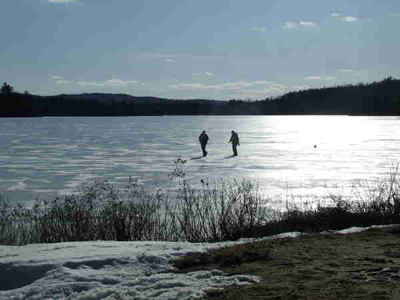
Picture by Johanna Young
A Snowless Winter…so far
The lack of snow this winter has many consequences, some good, some not so good and some remain to be seen.
Outdoor winter recreation is an economic driver for New Hampshire and this winter is a money loser so far. The ski areas are affected by the lack of snow, but fortunately they are able to make snow on cold nights and stay open so skiers can still enjoy their sport. Cross country skiers are out of luck, as well as sledders, snowmen builders and those that love a good snowball fight. If you want to get outside for a walk and explore, snowshoes aren't necessary, you can just take a hike and go just about anywhere you want to go. Snowmobilers are not happy and haven't been able to get their snow machines out on the trails at all. Ice fishing is spotty with the poor ice conditions and there are not as many bob houses on the lakes. Skating and hockey are not being enjoyed nearly as much and pond hockey tournaments have been cancelled.
On a positive note, towns are happy because their municipal snow removal budgets aren't being used and as a result getting around by car has been easier than most winters.
Animals such as deer and moose have had a lot easier time moving around and finding food this winter. The lack of snow, however, could result in larger tick populations, which can affect deer and moose detrimentally. Bird feeders aren't emptying as fast because there are more "natural" food sources available. While some species benefit and others have more trouble. Mice, moles and voles don't have their snow tunnel networks for moving around safely and finding food, they have to take their chances moving on open ground where predators can see them easily.
For farmers and gardeners the lack of snow insulating the ground will allow frost to penetrate deeper into the ground, which can mean some marginally hardy plants may not make it, as roots are generally not as hardy as shoots. The maple syrup season will likely be affected. One local sugar maker has tapped earlier than any past year - ever.
The warmth in the U.S. and Canada has led to extremely low ice levels -- the second least amount of ice cover since 1981 and there are drought like conditions. The snowless winter in New Hampshire could lead to a summer water shortage. Ground water not replenished by melting snow could be a problem for both farming and wells. Lake levels could be down this year if we don't get a lot of spring rain and there could be a higher chance for brush fires until the leaves are on the trees.
January 2012 was the fourth-warmest January on record for the contiguous United States. It's warmer this year mainly because of the jet stream pattern. For the most part, this winter, the jet stream has been on a west-to-east pattern. Meteorologists refer to this as a 'zonal flow.' There have been a lot of storms moving from west to east, but not a lot traveling northward or southward as is our usual pattern. We haven't been visited by the frigid arctic air masses nearly as often this winter.
BUT a shift in weather patterns could end our snowless winter in a hurry! There is, by tradition, a lot more time for winter snows to arrive through the months of March and April. Sometimes this is when our biggest storms can happen.
January:

Bluebird picture by Beth Donald
Bluebirds in Winter?
Sandy caught the sight of a bluebird pair in her yard this month and was very surprised. It seemed very unusual to her to see this delightful bird at this time of year.
The Eastern Bluebird is the only one of the 3 bluebird species regularly found in New Hampshire. It is a member of the thrush family and related to the American Robin. Adults are blue on their heads, backs, and tails, though the female's blue is spread over with gray-brown. They have a reddish orange breast and flanks that are offset by white bellies. Glimpsing a bluebird contrasted against the white snow is quite a stunning sight on a winter's day.
Peterson’s Field Guide for Eastern Birds shows the northern edge of the bluebirds’ year-round range along the Connecticut and Rhode Island coasts and out to the Cape. But, because of this winter's extensive warm spell some bluebirds haven't left New Hampshire. In mild winters bluebirds do stay around southeastern New Hampshire and their over wintering is most likely influenced by humans providing the necessary ingredients to make survival possible, such as nesting boxes and food.
They aren't bothered by the snow as they typically arrive at their nesting boxes in March, when the ground is still snow-covered. In spite of the snow, they get busy building their nests, beating out competing birds such as swallows and house wrens.
Bluebirds eat mostly insects in the summer season and wild fruit, berries and seeds in winter. They are attracted to peanut butter mixes, suet and fruit, but the bluebird's special favorite is mealworms. They perch erect on wires, posts, and low branches in open country, scanning the ground for prey. They feed by dropping to the ground onto insects in season or by perching on fruiting trees to gulp down berries, in fall and winter.
Bluebirds are usually found in fields, open woodlands, parks or along golf courses or other open areas, including suburban locations with open spaces and scattered trees.
All bluebirds are cavity nesters and will use an artificial nest box if provided. Natural habitat and nest cavities had been disappearing for many years, but bluebird populations have steadily increased for the past few decades due to thousands of bluebird nest boxes being installed across the country. Put up a few nesting boxes in your yard next year and see if the bluebirds move in. Maybe they will even stay for the winter!
To view yearly archives of our "New In
Nature" series click on year you wish to see.
2002
2003
2004
2005
2006
2007
2008
2009
2010
2011
2012
|


